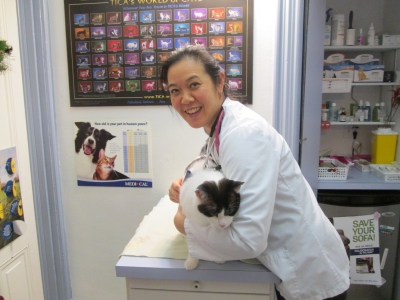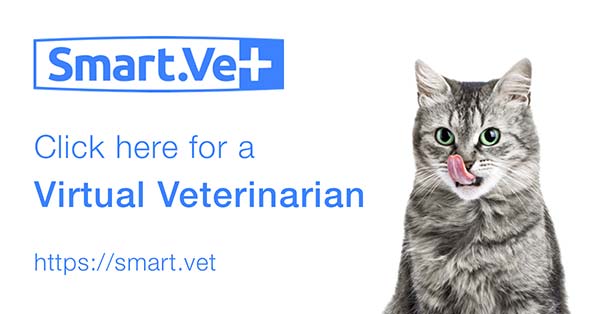One of the most important pieces of equipment needed in raising a kitten is a FOOD SCALE in grams to weigh the kitten daily, to make sure they are growing properly. If you do not have one, you can bring your kittens in to our office and weigh them on our scale. A kitten’s birth weight is usually between 90-120 grams. During the first to second week they should DOUBLE their weight and during their third to fourth week they should have TRIPLED their birth weight. The average daily gain should be 10-13 grams.
To tell how old a kitten is, these are some of the guidelines you can use:
Eyes open at 8-14 days (average 10)
Ears open at 6-14 days and will have functional hearing at 21 days.
Ability to stand at 5-25 days (average 10)
Sitting down at around 20 days
Walking unsteadily at around 20-21 days
If you find a kitten that has been exposed to the environment and is cold the first thing that must be done is to warm the kitten up VERY SLOWLY to prevent death. The best way to warm the kitten gradually is to share your own body heat by wrapping a towel around the both of you to keep the heat in.
1. HOUSING
Kittens must be confined in a warm, draft-free container. You can use a cardboard box, sanitized pet carrier, laundry basket etc., with thread-free towels or fleece. You will also need an external heat source because kittens do not self-regulate their body temperatures until they are 4 weeks old. Your external heat source may be a heating pad, hot water bottle, or heat lamp. Please be very careful not to get it too close or it will burn the kittens. The heat source should only be in one corner so the kittens may get away if they become too hot. The temperature gradient should be from 32-34°C (where the kittens will get most heat) to 24-27°C at far edge of container. Once kittens are 4 weeks old, environmental temperature should be around 24°C. If it is a large litter you may not have to provide as much heat because their own body heat will help warm each other as they snuggle together.
The humidity should be approximately 50 % around the kittens to prevent dehydration. Use a spray bottle, humidifier, or outside of the box (out of reach) leave a very shallow open dish of water.
2. GENERAL CARE
If the kittens are able to get at least some of mom’s milk they have a much better chance of surviving because they will get some immunity to diseases through the first milk called colostrum. If the kittens did not receive any colostrum or you do not know if they received any colostrum, they are at a greater risk for disease, so sanitary practice is very important.
Here are some Do’s and Don’ts:
1) DO NOT expose kittens to older animals (even if vaccinated).
2) DO NOT group multiple litters together.
3) CLEAN and sanitize with boiling water all feeding equipment, bedding and towels.
4) WASH hands thoroughly with disinfectant soap before handling kittens and after stimulation.
5) DO NOT prepare more formula than what you will use in a 24-hour period. Refrigerate all formula made up. If there is extra, discard it.
6) ONLY keep formula at room temperature for 1 hour. If longer discard it.
7) WARM only the amount of formula needed for that feeding in warm water. NOT in microwave.
3. FEEDING
Schedule
Kittens up to 2 weeks need to be fed every 2-3 hours with 1 night feeding.
Kittens 2-3 weeks old need to be fed every 4 hours. No night feeding is necessary but the kittens should not go much more than 6 hours without some nourishment.
Kittens 4-6 weeks old need feedings every 6 hours. No night feeding. They can go up to 8-10 hours without a feeding and by now they should be trying to eat on their own, so you can leave food with them all the time.
Formulas
Use a recommended kitten formula to feed the kittens. All recommended formulas will follow the recommended energy intake that a kitten needs to grow into a healthy cat. Follow the directions and feed the recommended amounts on the label. The recommended formulas are Mammalac (powdered or liquid), Esbilac, Nurturall (liquid) and KMR (powder or liquid).
All formulas should be heated (in warm water only) to 35-38°C. To test this put a drop on the inside of your wrist (just like your own baby). You should not be able to feel the milk there. As the kittens get older you can feed the formula at room temperature.
Kittens must be fed the formula till they are about 4 weeks old. You can then start to mix in a small amount of canned kitten food to the formula on a shallow saucer to get them used to a different taste. Gradually, you can start getting them to eat out of a bowl. As they get better at this add more kitten food and less formula until you do not add any formula at all. As you add less formula make sure you have a shallow bowl of water out now for them to drink from.
Feeding Methods
No matter what the method of feeding you choose, the proper position of the kitten is important to prevent the formula from going into the lungs. Hold the kitten so the belly is in the palm of your hand and have the head slightly tilted up.
Syringe/eye dropper method
This method is preferred for healthy but not strong sucking kittens.
Fill the syringe to the amount kitten should eat, put to mouth and let 1 drop at a time drip out so the kitten can swallow it with out choking. Keep a record of the amount fed at each feeding. Once the kitten gets the hang of this, it will probably start to suck on the end of the syringe itself and move the plunger on its own. When this happens you can put him/her on a bottle.
Bottle method
This method is preferred for healthy, strong sucking kittens. This is also the more natural way for the kitten to feed, because it will suck until it’s full, then stop.
The nipple is very important in feeding. You will have to put your own hole in it. The hole must only let one drop of milk out at a time when bottle is held upside down. If milk pours out of the hole, it is too big and the kitten will aspirate (breathe into lungs) the milk. If you have to squeeze the bottle to get the milk to drip, the hole is not big enough and the kitten will tire out or get flustered and not get the amount of milk needed.
4. STIMULATION
Young kittens need to be stimulated to urinate and defecate. This is a simple procedure to do. All that is needed is a soft cloth, cotton ball or Kleenex and some warm water. Wet the cloth, and then gently rub the genital area simulating the mother’s grooming. Most of the time the kitten will urinate first, then defecate. This procedure should be done after every feeding and the kitten should pass both urine and feces. Make sure you keep track of amount and consistency of the stool. You don’t want the kitten to become constipated just because he/she was not stimulated enough to pass stool on a regular basis.
If the kitten gets diarrhea, reduce the amount of formula given either buy giving less or by diluting it with water. If the diarrhea continues for 24 hours contact the clinic immediately.
Stimulation of the kitten is usually done until the kitten is 3-4 weeks old. At this time you can introduce a litter box to the kittens. They will not know what to do with it so at the beginning, stimulate them over the box so that their urine and bowel movements scent is in it. Most of the time nature will take it from there to get kittens litter box trained. The litterbox at first should not have sides higher then 1 inch so the kittens can crawl in and out of the box.
5. DEHYDRATION
The lack of regular liquids, diarrhea, an environment that is too warm or dry can cause kittens to become dehydrated. This is important to detect early! Kittens can quickly become very ill and may actually die from dehydration.
You can detect dehydration in their skin and mucous membranes. To check the skin: if you give the loose skin at the back of the neck a slight twist; it should flatten back to normal immediately; if it takes some time or it stays in that twist, call us at the Central Cat Hospital immediately. To check mucous membranes feel the inside of the mouth: if it is moist, slick like your own the kitten is fine; if the mouth is sticky/tacky or dry please call us immediately.
6. SOCIAL ENVIRONMENT
Kittens need to be socially stimulated to grow into being friendly, outgoing cats. Kittens that have been raised without this social stimulation can develop abnormal behavior patterns and may become increasingly suspicious and aggressive adults. This is difficult to overcome when you are raising a single kitten.
Hand raising will sometimes bring out the behavior of nursing on the other kittens causing trauma to the skin. If this occurs you must separate the kittens into different boxes or put up dividers and only let them be socialized with your supervision. Most kittens will grow out of this behaviour.
If you have any questions, problems or concerns, please call us at 660-0300.


